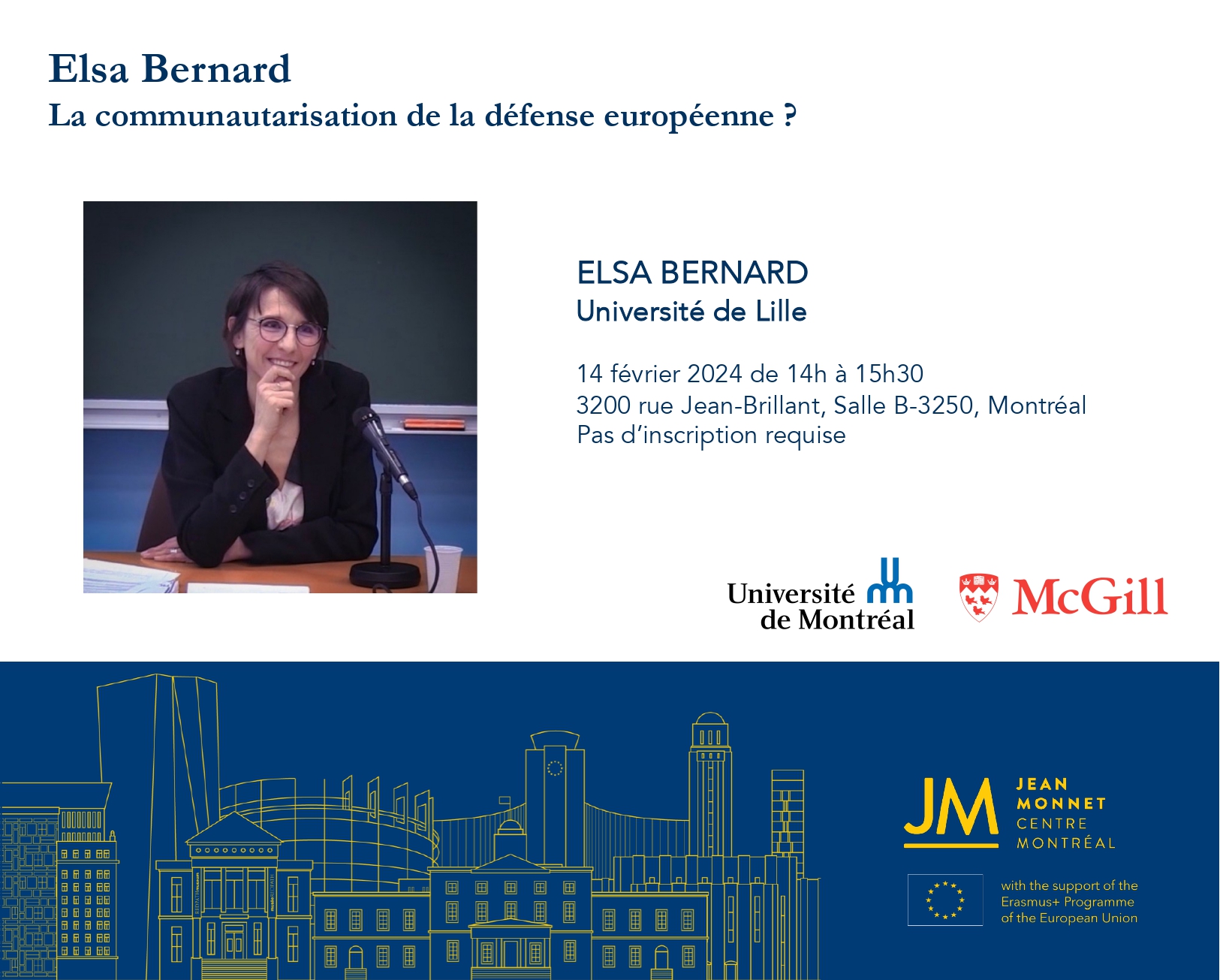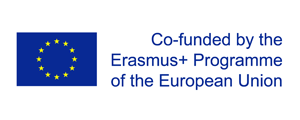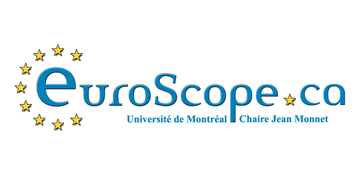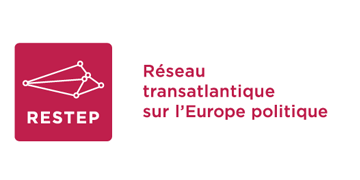RevUE of Elsa Bernard’s conference by Tom Lamour

« La communautarisation de la défense européenne ? », February 14, 2024, with Elsa Bernard (University of Lille).
The conference held on February 14, 2024, entitled “La communautarisation de la défense européenne ?”, was presented by Elsa Bernard, a professor of public law at the University of Lille and holder of the Jean Monnet Chair on “L’appartenance à l’UE”.
The conference was divided into three points, starting from a broad overview of European defense to a more specific discussion on the challenges posed by this topic.
Firstly, Elsa Bernard wished to revisit the term “communalization,” which she admitted was somewhat provocative due to the fact that this pillar entails the loss of sovereignty by states through the delegation of powers to European institutions. The Commission becomes the initiating body, and the texts adopted follow the ordinary legislative procedure. Thus, a state may implement a decision contrary to its will. The title of this conference invites us to think not of a pooling of defense but rather of its Europeanization.
Secondly, our speaker specifically addressed the issue of European defense. Through legal analysis, she showed us that European defense is enshrined in the preamble and Article 42 of the Maastricht Treaty, but the ambivalence of its formulation leads us to question integration in this domain, especially since 23 EU states are members of NATO. However, Elsa Bernard wanted to demonstrate to us that European defense is actually an active domain, albeit in a non-coercive dimension: it has been conducting missions since 2003 as part of interventions similar to UN peacekeeping missions. However, the recent deterioration of the geopolitical climate has strengthened the desire to establish a European defense, exemplified by the creation of the Permanent Structured Cooperation (PESCO), etc.
Elsa Bernard concluded her intervention by questioning the relevance of current European defense. She showed that, following the same process of communalization as in other areas, the Commission uses the market to integrate defense, particularly through industry and research, which fall under its purview. Europe has been investing in defense tools and plans since 2009, leading to the establishment of special funds for states to produce ammunition collectively. Among these funds, the European Defense Fund (EDF) stands out.
This European defense strategy aligns with the recent adoption of the “European Defence Industry Reinforcement Through Common Procurement Act” (EDIRPA) and the “Act in Support of Ammunition Production” (ASAP), during which several hundred million euros were invested by the EU in a perspective of joint purchases and productions of ammunition to aid Ukraine and maintain sufficient stocks at the national level. These regulations illustrate the ambiguity surrounding common defense, with an ambitious goal of pooling resources on one hand, but on the other hand, communal aspirations of the Commission being curtailed by the European Council.
This conference was particularly enlightening in the current geopolitical context, during which former US President Donald Trump, while campaigning, encouraged Russia to invade states that were not paying their fair share to NATO. Since the majority of these states are European, the question of a European defense makes increasingly more sense in this highly tense context.
Comments are closed.
Subscribe to our newsletter
Calendrier du CJMM / JMCM calendar
May 2024
| MMonday | TTuesday | WWednesday | TThursday | FFriday | SSaturday | SSunday |
|---|---|---|---|---|---|---|
29April 29, 2024
|
30April 30, 2024
|
1May 1, 2024
|
2May 2, 2024
|
3May 3, 2024
|
4May 4, 2024
|
5May 5, 2024
|
6May 6, 2024
|
Colloque étudiant du CJMM – Le Centre Jean Monnet vous convie à son colloque étudiant, une occasion unique pour les étudiant·e·s affilié·e·s au CJMM de briller et de partager leurs travaux !
Date: Mardi 7 mai 2024 Heure: 10h30 – 16h Lieu: Université de Montréal, Pavillon Lionel-Groulx, Salle C-2059 Venez découvrir les recherches novatrices de nos étudiant·e·s et participez à des discussions captivantes. Une opportunité inestimable pour élargir vos horizons et enrichir vos connaissances ! |
8May 8, 2024
|
9May 9, 2024
|
10May 10, 2024
|
11May 11, 2024
|
12May 12, 2024
|
13May 13, 2024
|
14May 14, 2024
|
15May 15, 2024
|
Table-ronde – Quelles perspectives pour les élections européennes ? – Le Centre pour l’Étude de la Citoyenneté Démocratique, la Chaire de Recherche du Canada en Démocratie Électorale, la Maison de l’Europe à Montréal et le Centre Jean Monnet de Montréal ont le plaisir de vous inviter à une table-ronde captivante animée par Luca Sollai de l’Université de Montréal, sur le thème des élections européennes 2024. Nos conférenciers d’exception, Daniel Stockemer de l’Université d’Ottawa, Jae-Jae Spoon de l’University of Pittsburgh et Laurie Beaudonnet de l’Université de Montréal, apporteront leur expertise pour enrichir les échanges. Date : Jeudi 16 mai 2024 Après la table-ronde, prolongez les discussions autour d’un cocktail-exposition dédié aux élections européennes dans les 27 États membres dans la salle C-2081 du Pavillon Lionel-Groulx. Ne manquez pas cette opportunité unique de vous informer et d’échanger sur un sujet crucial pour l’avenir de l’Europe. |
17May 17, 2024
|
18May 18, 2024
|
19May 19, 2024
|
20May 20, 2024
|
21May 21, 2024
|
22May 22, 2024
|
23May 23, 2024
|
24May 24, 2024
|
25May 25, 2024
|
26May 26, 2024
|
27May 27, 2024
|
Sophie Jacquot - Cycle de conférences – Rejoignez Sophie Jacquot (UCLouvain Saint-Louis – Bruxelles) lors de notre dernier événement du cycle de conférences de l’hiver 2024, intitulé « Sur l’utilité et le rôle de l’échec dans les politiques européennes : l’exemple de la mise en œuvre de l’égalité salariale ». La conférence se tiendra de 11h30 à 13h00 à l’Université de Montréal, au Pavillon Lionel-Groulx, Salle C-2059. Cet événement est organisé en partenariat avec le Réseau Perspectives Féministes, le Centre d’excellence Jean Monnet: Un-Muting Europe (EUNMUTE) et la Chaire Jean Monnet EU GENDERING. La conférence sera en français. Pas d’inscription requise. |
29May 29, 2024
|
30May 30, 2024
|
31May 31, 2024
|
1June 1, 2024
|
2June 2, 2024
|
Our partners
Funded by the European Union. Views and opinions expressed are however those of the author(s) only and do not necessarily reflect those of the European Union or the European Education and Culture Executive Agency (EACEA). Neither the European Union nor EACEA can be held responsible for them.
Contact us

at University of Montreal
3744, Jean-Brillant St., 515-60
Montreal (Quebec), H3T 1P1
(514) 343-6111 #0782
at University McGill
3438 McTavish St., 3rd floor
Montreal (Quebec) H3A 0E4

centre@jeanmonnet.ca








